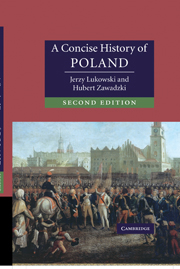Book contents
- Frontmatter
- Contents
- List of illustrations
- Preface to the second edition
- Preface to the first edition
- A note on Polish pronunciation
- Chronology
- PART I POLAND, TO 1795
- 1 PIAST POLAND, ?–1385
- 2 JAGIELLONIAN POLAND, 1386–1572
- 3 THE COMMONWEALTH OF THE TWO NATIONS, 1572–1795
- PART II POLAND, AFTER 1795
- Generalogical charts of Polish rulers
- List of heads of state, presidents, Communist Party leaders (1918–2005)
- Bibliography
- Index
- Title in series
2 - JAGIELLONIAN POLAND, 1386–1572
Published online by Cambridge University Press: 05 June 2014
- Frontmatter
- Contents
- List of illustrations
- Preface to the second edition
- Preface to the first edition
- A note on Polish pronunciation
- Chronology
- PART I POLAND, TO 1795
- 1 PIAST POLAND, ?–1385
- 2 JAGIELLONIAN POLAND, 1386–1572
- 3 THE COMMONWEALTH OF THE TWO NATIONS, 1572–1795
- PART II POLAND, AFTER 1795
- Generalogical charts of Polish rulers
- List of heads of state, presidents, Communist Party leaders (1918–2005)
- Bibliography
- Index
- Title in series
Summary
Jogaila of Lithuania was received into the Catholic Church in Kraków cathedral on 15 February 1386. His baptismal name, Władysław, harked back to Łokietek, re-unifier of the ‘Crown’, the kingdom of Poland – reason enough for Ernst von Zöllner, Grand Master of the Teutonic Knights, to decline the invitation to stand as godfather. In the autumn of 1387, Peter I Mushat, hospodar of Moldavia, transferred allegiance and homage for his lands from the rulers of Hungary to Władysław and Jadwiga of Poland. He and Zöllner recognized that a new power had arrived. Barely a hundred years later, not only Poland and Lithuania, but Hungary and Bohemia had come under Jagiellonian rule. It was the greatest dynastic concatenation of territory Europe had yet seen.
Appearances flattered to deceive. In 1386, it was the Teutonic Knights who menaced the existence of Lithuania. Only three years before, they had capped over a century of bloody, unremitting effort by sacking much of the Lithuanian capital of Vilnius and destroying the great stronghold of Trakai. Lithuania was riven by civil war; western, ‘lower’ Lithuania, Žemaitija, had been ceded to the Teutonic Order by Jogaila's cousin and rival, Vytautas, in return for its support. The union with Poland and the acceptance of Latin Christianity were a desperate gamble by Jogaila to avert a seemingly inevitable subjugation.
Lithuania, stretching from the Baltic in the north to the Black Sea in the south, to the upper Volga and beyond the Dnieper in the east, was a highly unstable political entity.
Information
- Type
- Chapter
- Information
- A Concise History of Poland , pp. 38 - 82Publisher: Cambridge University PressPrint publication year: 2006
